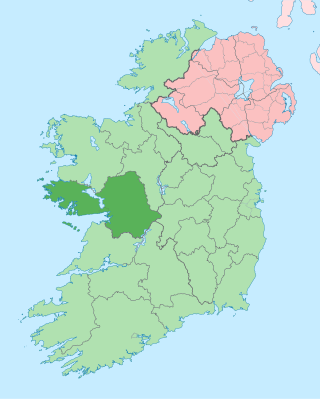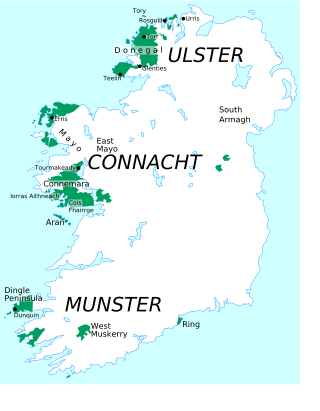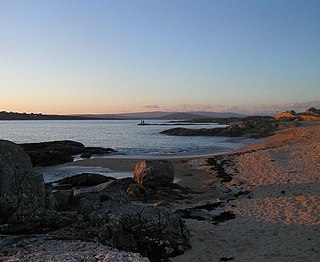
County Galway is a county in Ireland. It is in the Northern and Western Region, taking up the south of the province of Connacht. The county population was 276,451 at the 2022 census.

A Gaeltacht is a district of Ireland, either individually or collectively, where the Irish government recognises that the Irish language is the predominant vernacular, or language of the home. The Gaeltacht districts were first officially recognised during the 1920s in the early years of the Irish Free State, following the Gaelic revival, as part of a government policy aimed at restoring the Irish language.
RTÉ Raidió na Gaeltachta, abbreviated RnaG, is an Irish language radio station owned and operated by Raidió Teilifís Éireann (RTÉ). The station is available on FM in Ireland and via satellite and on the Internet. It celebrated 40 years on air on 2 April 2012. The station's main-headquarters are in Casla, County Galway with major studios also in Gaoth Dobhair, County Donegal and Ballydavid, County Kerry.

Connemara is a region on the Atlantic coast of western County Galway, in the west of Ireland. The area has a strong association with traditional Irish culture and contains much of the Connacht Irish-speaking Gaeltacht, which is a key part of the identity of the region and is the largest Gaeltacht in the country. Historically, Connemara was part of the territory of Iar Connacht. Geographically, it has many mountains, peninsulas, coves, islands and small lakes. Connemara National Park is in the northwest. It is mostly rural and its largest settlement is Clifden.

The Rosses is a geographical and social region in the west of County Donegal, Ireland, with a population of over 7,000 centred on the town of Dungloe, which acts as the educational, shopping and civic centre for the area. Defined by physical boundaries in the form of rivers, as well as history and language use, the area has a distinctive identity, separate from the rest of Donegal. The extensive region lies between the parish of Gweedore to the north and the town of Glenties to the south. A large part of the Rosses is in the Gaeltacht, which means that Irish is the spoken language. The Rosses, Cloughaneely and Gweedore, known locally as "the three parishes" with 16,000 Irish speakers, together form a social and cultural region different from the rest of the county, with Gweedore serving as the main centre for socialising and industry. Gaeltacht an Láir is another Irish-speaking area.

Carraroe is a village in Connemara, the coastal Irish-speaking region (Gaeltacht) of County Galway, Ireland. It is known for its traditional fishing boats, the Galway Hookers. Its population is widely dispersed over the Carraroe peninsula between Cuan an Fhir Mhóir and Cuan Chasla. Carraroe has an unusual beach, Trá an Dóilín, a biogenic gravel beach made of coralline algae known as "maerl".

Máirtín Ó Cadhain was one of the most prominent Irish language writers of the twentieth century. Perhaps best known for his 1949 novel Cré na Cille, Ó Cadhain played a key role in reintroducing literary modernism into modern literature in Irish, where it had been dormant since the 1916 execution of Patrick Pearse. Politically, Ó Cadhain was an Irish republican and anti-clerical Marxist, who promoted the Athghabháil na hÉireann, . Ó Cadhain was also a member of the post-Civil War Irish Republican Army and was interned by the Irish Army in the Curragh Camp with Brendan Behan and many other IRA members during the Emergency.

Rossaveal or Rossaveel is a Gaeltacht village and townland in the Connemara area of County Galway, Ireland. It is the main ferry port for the Aran Islands in Galway Bay. It is about 37 kilometres (23 mi) from Galway city.

Béal an Daingin or Béal a' Daingin is a small Gaeltacht village in Connemara (Conamara), County Galway, Ireland. The primary spoken language is Irish, and all but a few of the elderly population also speak English. There is a pub, a post office and a primary school (Toureen) within a few miles of the village.

Connacht Irish is the dialect of the Irish language spoken in the province of Connacht. Gaeltacht regions in Connacht are found in Counties Mayo and Galway. Connacht Irish is also spoken in the Meath Gealtacht Ráth Chairn and Baile Ghib. The dialects of Irish in Connacht are extremely diverse, with the pronunciation, forms and lexicon being different even within each county.

Caitlín Maude was an Irish poet, language revival activist, teacher, actress, and traditional singer. She is also well-known for her campaigns to improve the lives of women in Ireland.

Joyce Country is a cultural region in counties Galway and Mayo in Ireland. It is sometimes called Partry, after the former tribal territory of the Partraige, which it largely matches. Part of it falls within the Connacht Gaeltacht. Joyce Country lies on the shores of Lough Mask and Lough Corrib, and includes the Partry Mountains. It is a rural area that includes small settlements such as Clonbur, Cong, Cornamona and Toormakeady. It borders Connemara, to its south and west.

Cloughaneely is a district in the north-west of County Donegal in Ireland. This is a mainly coastal area with a population of over 4,000 centred on the towns of Falcarragh and Gortahork. It is a Gaeltacht area, meaning the Irish language is spoken as the primary language. Cloughaneely includes the secondary school Pobalscoil Chloich Cheannfhaola, with just under 500 students. Places of interest include Cnoc na Naomh, considered to be a mountain with religious significance. Cloughaneely, The Rosses and Gweedore, known locally as "the three parishes" with 16,000 Irish speakers, together form a social and cultural region different from the rest of the county, with Gweedore serving as the main centre for industry.
Rónán Mac Con Iomaire is the Director of Regional & Community Development & Language with Údarás na Gaeltachta and is an Irish author and broadcaster.
Iorras Aithneach is an Irish-speaking peninsula in the West of County Galway with about 2,000 people living in the area. It is a predominantly Irish-speaking area, with 80% able to speak the language.

Cois Fharraige, previously spelled Cois Fhairrge, is a coastal area west of Galway city, where the Irish language is the predominant language. It stretches from Na Forbacha, Bearna, An Spidéal to Indreabhán. There are between 8,000 and 9,000 people living in this area.
The Gaeltacht Corca Dhuibhne is located on the western end of the Dingle peninsula in County Kerry, Ireland. It's a predominantly Irish-speaking area. It stretches from Abhainn an Scáil to Dún Chaoin and An Clochán to An Daingean. The villages in the area are Abhainn an Scáil, Lios Póil, Daingean Uí Chúis, Ceann Trá, Dún Chaoin, Baile an Fheirtéaraigh, Baile na nGall and An Clochán. There are between 6,000–7,000 people living in the region and over 3,000 are Irish speaking.
Gaeltacht an Láir is an Irish-speaking area in central County Donegal, Ireland. It centres on the village of Baile na Finne and stretches south to Gleann Colm Cille and north to Fanad and Rosguill. There are nearly 7,000 people living in the area and 2,000 daily Irish speakers.
There are three Irish-speaking areas in County Mayo; Erris, Achill island and Toormakeady. Erris is located in North-West Mayo, Achill island is directly south of Erris and Tourmakeady is along the border with County Galway. There are nearly 2,500 daily Irish speakers in these areas.
Amárach was an Irish-language weekly newspaper founded in 1956 by Peadar Ó Ceallaigh (1913–2000), a Donegal native living in Co Meath, who also headed the organization "Muintir na Gaeltachta". The newspaper's subtitle was "Guth na Gaeltachta", and Amárach aimed to serve the Irish-speaking population of the Gaeltacht areas. Ó Ceallaigh edited and published the paper, which was printed in Ballyshannon, until May 1977, when it was sold to Comharchumann Chois Fharraige. Thereafter the paper was published and printed in Conamara, until in 1984 it was merged with the Dublin-based Irish-language paper Inniú to form the weekly newspaper Anois.









